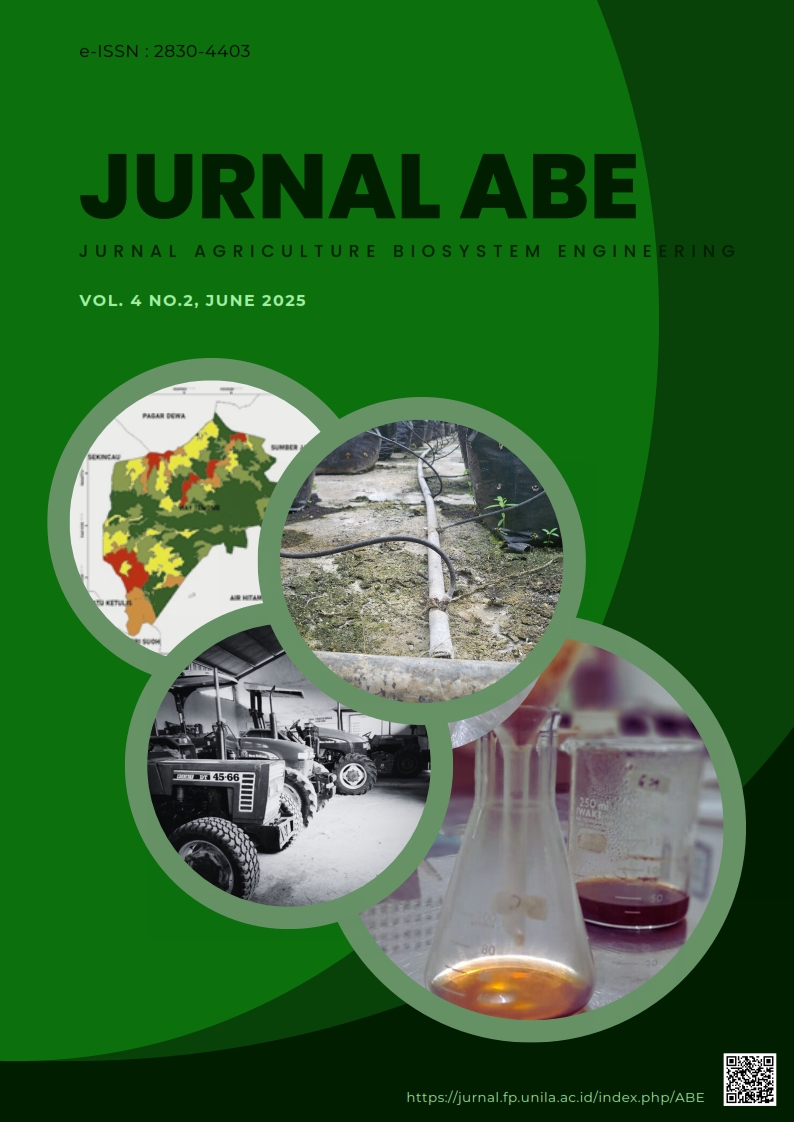Pengaruh Ukuran dan Warna Kerabang Telur Itik Terhadap Hasil Pengasinan
DOI:
https://doi.org/10.23960/jabe.v4i3.11595 Abstract View: 121
Abstract View: 121
Keywords:
Salted duck eggs, Egg size, shell color, Egg shellAbstract
This study aims to study the effect of shell color and duck egg size on salting results. The method used in this study is a factorial Completely Randomized Design (CRD) with 3 treatment levels and 3 replications. The first factor is egg size and the second factor is duck egg shell color. The parameters observed were thickness, weight changes, texture, NaCl, and organoleptics such as aroma, color, texture, saltiness and preference. Data from the observation results will be analyzed using analysis of variance (ANOVA) followed by the HSN (Honest Significant Difference) test if there is a significant effect. The results showed that the treatment of duck egg shell size had a significant effect (Fhit>Ftab) on the thickness of texture, NaCl, aroma organoleptic and texture of mash. Then the interaction of treatments had a significant effect (Fhit>Ftab) on organoleptic mash. While the color treatment did not have a significant effect (Fhit<Ftab) on all parameters. The conclusion obtained in this study is that the larger the egg size, the higher the thickness, texture, organoleptic aroma and flavor values of salted duck eggs, while the NaCl content is lower.
Downloads
References
Andriyanto, A., Andriani, M. A. M. dan Widowati, E. 2013. Pengaruh Penambahan Ekstrak Kayu Manis Terhadap Kualitas Sensoris, Aktivitas Antioksidan dan Aktivitas Antibakteri Pada Telur Asin Selama Penyimpanan Dengan Metode Penggaraman Basah. Jurnal Teknosains Pangan, 2(2): 13–20.
Asiah, N. 2021. Prediksi Umur Simpan Dan Nilai Penurunan Mutu Telur Asin Presto Pada Penyimpanan Suhu Rendah. Jurnal Teknologi Pangan Dan Kesehatan (The Journal of Food Technology and Health). https://doi.org/10.36441/jtepakes.v1i2.185
Irmawaty, I. 2018. Penggunaan Metode Berbeda pada Pembuatan Telur Asin Terhadap Rasa dan Aroma. Jurnal Ilmu dan Industri Peternakan, 4(1), 84-92.
Juliambarwati, M,. Rantriyanti, A. dan Hanifa, A. 2012. Pengaruh Penggunaan Tepung Limbah Udang dalam Ransum Terhadap Kualitas Telur Itik. Jurnal Sains Peternakan Vol. 10(1).
Koswara, S. 2009. Teknologi Pengolahan Telur (Teori dan Praktek). eBookPangan.com.
Lukito, G.A., A. Suwarastuti dan A. Hintono. 2012. Pengaruh Berbagai Metode Pengasinan Terhadap Kadar NaCl, Kekenyalan dan Tingkat Kesukaan Konsumen pada Telur Puyuh Asin. Jurnal Animal Agriculture. 1(1): 829-838.
Meiliany, I. D., Kurniawan, A. K., Hidayat, R. N., Mutmainah, S., Ana, S. S., dan Hasdar, M. 2024. Organoleptik telur puyuh asin yang direbus dengan larutan garam. Journal of Technology and Food Processing (JTFP), 4(01), 10-21.
Nursiwi, A., Darmadji, P., dan Kanoni, S. (2013). Pengaruh penambahan asap cair terhadap sifat kimia dan sensoris telur asin rasa asap. Jurnal Teknologi Hasil Pertanian, 6(2).
Purdiyanto, J. dan Riyadi, S. 2018. Pengaruh lama simpan telur itik terhadap penurunan berat, indeks kuning telur (IKT), dan haugh unit (HU). Maduranch: Jurnal Ilmu Peternakan, 3(1): 23-28.
Ramli, I., dan Wahab, N. 2020. Teknologi pembuatan telur asin dengan penerapan metode tekanan osmotik. ILTEK: Jurnal Teknologi, 15(02), 82-86.
Rasyid, N. Q., Anita, A., dan Feri, F. 2016. Kadar NaCl dan kadar protein telur asin berdasarkan lama pengeraman. Jurnal Medika, 1(1), 1-5.
Rukmiasih, R., Ulupi, N., dan Indriani, W. 2015. Sifat fisik, kimia, dan organoleptik telur asin melalui penggaraman dengan tekanan dan konsentrasi garam yang berbeda. Jurnal Ilmu Produksi Dan Teknologi Hasil Peternakan, 3(3), 142– 145.
Sahara, E., Prayuda, B., Sandi, S., Yosi, F., Muslim, G., dan Triyanto, A. 2023. Peran Larutan Kitosan dan Ekstrak Daun Jambu Biji dalam Mempertahankan Kualitas Internal Telur Itik. In Seminar Nasional Lahan Suboptimal (Vol. 10, No. 1, pp. 113-119).
Septiana, N., dan Nova, K. 2015. Pengaruh lama simpan dan warna kerabang telur itik Tegal terhadap indeks albumen, indeks yolk, dan pH telur. Jurnal Ilmiah Peternakan Terpadu, 3(1).
Thohari, I., dan Rosyidi, D. 2015. Pengaruh kosentrasi sari kunyit putih (Curcuma zediaria) terhadap kualitas telur asin ditinjau dari aktivitas antioksidan, total fenol, kadar protein dan kadar garam. Jurnal Ilmu dan Teknologi Hasil Ternak, 10(1), 46-53.
Wahju, J. 2004. Ilmu Nutrisi Unggas. Cetakan ke-5. Gadjah Mada University Press, Yogyakarta.
Wang, X., Zhang, J., Vidyarthi, S. K., Xu, M., Liu, Z., Zhang, C., dan Xiao, H. 2024. A comprehensive review on salted eggs: quality formation mechanisms, innovative pickling technologies and value-added applications. Sustainable Food Technology.
Warna, K. D. A. N. 2020. Pengaruh Lama Penggaraman Terhadap Kualitas Cured Egg Yolk Ditinjau Dari Kadar Lemak, Asam Lemak Bebas.
Wulandari, Z. 2004. Sifat fisikokimia dan total mikroba telur itik asin hasil teknik penggaraman dan lama penyimpanan yang berbeda. Media Peternakan, 27(2).
Yuwanta, T. 2010. Telur dan Kualitas Telur. Yogyakarta, Gadjah Mada University Press.
Zuhri, B. N., Setiawan, I., dan Garnida, D. 2022. Karakteristik telur itik lokal yang disimpan pada suhu ruang dengan lama penyimpanan berbeda. Jurnal Produksi Ternak Terapan (JPTT), 3(1), 1-8.
Downloads
Published
How to Cite
Issue
Section
License
Copyright (c) 2025 Rio Edy Saputra Purba, Tamrin Tamrin, Winda Rahmawati, Warji Warji

This work is licensed under a Creative Commons Attribution-NonCommercial-ShareAlike 4.0 International License.
Authors who publish with this journal agree to the following terms:
Authors retain copyright and grant the journal right of first publication with the work simultaneously licensed under a Creative Commons Attribution-ShareAlike 4.0 International Lice that allows others to share the work with an acknowledgement of the work's authorship and initial publication in this journal.
Authors are able to enter into separate, additional contractual arrangements for the non-exclusive distribution of the journal's published version of the work (e.g., post it to an institutional repository or publish it in a book), with an acknowledgement of its initial publication in this journal.
Authors are permitted and encouraged to post their work online (e.g., in institutional repositories or on their website) prior to and during the submission process, as it can lead to productive exchanges, as well as earlier and greater citation of published work (See The Effect of Open Access).
Jurnal Agricultural Biosystem Engineering

JABE is licensed under a Creative Commons Attribution-ShareAlike 4.0 International License.




